Vietnamese food is strongly influenced by Cantonese cooking, seeing how people have commingled across borders over the millennia. Delicious culinary exchanges have resulted and one of the dishes that has become very popular in Vietnam is the chrysanthemum hot pot, a classic preparation called ta pien lu in Cantonese and ta pin lu Vietnamese. It's simple and easy, a festive preparation that I like to make for cool weather meals.
Most of the prep is done ahead and you get to mix and match ingredients. In fact, it's better when there's a marriage of land and sea. If you're unfamiliar with Chinese hot pots, it's like a fondue but you're dipping a raw morsel in stock to cook it, then dunk it in a sauce to eat.
According to Florence Lin's Cooking with Fire Pots, the chrysanthemum hot pot was traditionally seasoned with the petals of white chrysanthemums, which are considered unsafe in America since they are commonly sprayed. She decorates her platters with a large chrysanthemum to make up for the difference.
Handy hot pot hints:
- Cooking vessel: I use a 1970s electric wok that my mother got from a yard sale. You can use an electric skillet, or put a shallow pot atop an electric burner. Make sure the cord is safely set aside so no one (typically me in our home) trips over it. Make sure everyone can reach for the cooking vessel with their chopsticks.
- Stock: Should be lightly salted since it will be boiled down and seasoned by all the ingredients. I like to doctor up canned chicken broth for a quick approach, but you can use a seafood, pork, beef, or vegetable stock.
- Sauce: There is a wide range. Aside from the one below, consider using one that's you'd dip an Asian dumpling in. The egg in the sauce below adds unctuousness.
- Meats and seafood: You don't need much but aim for variety. Go to a butcher counter where you can get a single pork chop, small steak, a handful of shrimp, etc. Set aside a little of this and that from the night before to put into your hot pot. I save a chunk of fish, for example. Asian markets often have various kinds of pork and beef pre-sliced for hot pots.
- Tofu: Is present in many hot pots as a protein source but also a delightful vehicle for soaking up the flavorful stock. Use a tender medium or medium-firm tofu for best results as it turns creamy and rich tasting. The warmed tofu is conceptually just like Japanese warm simmered tofu (yu dofu, Asian Tofu page 87), a remarkable classic.
- Vegetables: I always have 1 or 2 leafy greens because they inject flavor in the broth. Napa cabbage lends a wonderful sweetness. Mustard greens offer a nice bite. Beyond that, fresh or rehydrated dried mushroom, carrot, bok choy, whatever you like to eat.
- Noodles: Cellophane (glass noodles) are traditional as, like tofu, are great for soaking up the cooking liquid. Plus, you don't have to pre-cook them. Very convenient.
- Cooking order: If there's a vegetable that needs longer cooking time, put it in at the front end. The noodles are kept till the end when they're added to create a soup. Traditionally, this hot pot is served at the end of a formal banquet with less stuff; all the raw ingredients would be added to the pot at once then served.
- Leftovers: Cook up the remains as a stir-fry the next day.
This is a slow, cook-it-yourself kind of meal. Set it up, relax with some wine or beer, and enjoy the food. Flavors develop and the hot pot gets transformed as you eat. At the end, even though you're full, you'll slurp up the remaining broth and noodles.
RECIPE
Chrysanthemum Hot Pot
In general, I keep the stock and sauce constant and vary the items to be cooked. The guide below helps you to shop for ingredients. Select what looks freshest and best at the market. Use clams instead of shrimp, for example. In the photos in this post, I used fresh shiitake, maitake, and yellow foot mushroom.
Serves 4
Stock
2 cans chicken broth plus 1 can full of water
2 large scallions
1 ½ inch fresh ginger, sliced into coins and smashed
Shrimp shells and any other trim bits from the meats below
Sauce
1 extra-large egg, beaten well
Heaping ¼ teaspoon sugar
2 tablespoons light (regular) soy sauce
1 ½ tablespoons oyster sauce
1 ½ tablespoons sesame oil
1 ½ tablespoons mince green onion
½ teaspoon toasted, ground Sichuan peppercorn, optional
Seasoned protein
4 to 6 ounces chicken breast
4 to 6 ounces boneless pork shoulder or fatty pork chop
4 to 6 ounces marbly beef steak
4 to 6 ounces mild tasting fish, such as cod or snapper
12 large shrimp, peeled and deveined (save the shells for the stock)
Kosher salt
White pepper
1 to 2 teaspoons Shaoxing rice wine or dry sherry
1 to 2 teaspoons canola or fragrant peanut oil
Tofu, vegetables and noodles
1 pound medium or medium-firm tofu, cut into 1-inch cubes
10 to 12 ounces napa cabbage, cored and cut crosswise into 2-inch-wide pieces
6 to 8 ounces bok choy, mustard greens, or chrysantheum greens, cut into large pieces
½ medium carrot, thinly sliced on the diagonal
2 to 4 ounces fresh mushroom, cut into bite size pieces, as appropriate
2 ounces dried cellophane noodles, soaked in hot water until pliable, cut into 5 to 6 inch lengths
1. For the stock, combine all the ingredients and simmer for 15 to 20 minutes. Cover and keep warm till you need it. Or turn it off if you're cooking hours in advance. Strain before using.
2. Meanwhile, stir together the sauce ingredients, combining well. Set at the table.
3. Cut the chicken, pork, beef, and fish into thin slices. Angle the knife, if needed, to get wide pieces as the stuff shrinks in the hot broth. For the meat and chicken, 1/16 to ⅛ inch thick works well. Cut the fish thicker. Chill the meat to make it easier to cut. Cut the shrimp into two symmetrical halves and add to the platter.
As you work, arrange the ingredients on 2 large platters as flat as possible. Sprinkle lightly with salt and pepper. Drizzle on the rice wine and oil. Set at the table or cover with plastic and refrigerate for a couple of hours before serving; return to room temperature before serving.
4. Arrange the tofu and vegetables on 2 platters and set at the table or refrigerate, like you did with the seasoned proteins. Put the noodles on a separate plate so you don't mix them up. Set the tofu, vegetables and noodles at the table, or cover keep at room temperature.
5. Heat the stock in your cooking vessel at the table. Bring it to a boil, then lower the heat to a simmer. Maintain the heat at that level throughout the meal.
6. Serve the sauce in individual rice bowls. Invite guests to dip the raw ingredients in the sauce before they cook it in the stock. Or, just cook the stuff directly in the stock. With exception to the bulleted guidelines above, I don't follow any precise order when eating hot pot but some people eat the meat first then add the vegetables. I like to mix things up. You could have rice on the side but I find it unnecessary.
Are you a hot pot lover? What do you like to dunk into the broth? There are many styles of hots pots too. What's yours?
Related post: Kyoto-style sukiyaki







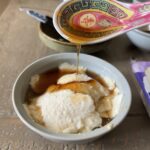
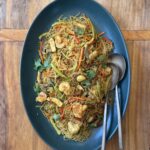
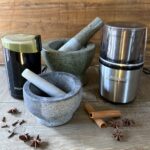



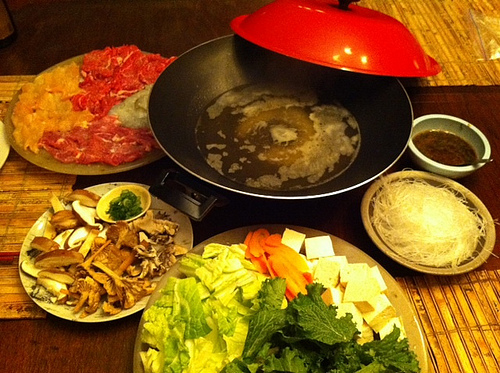
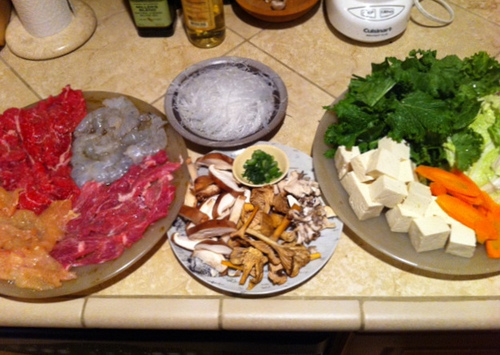
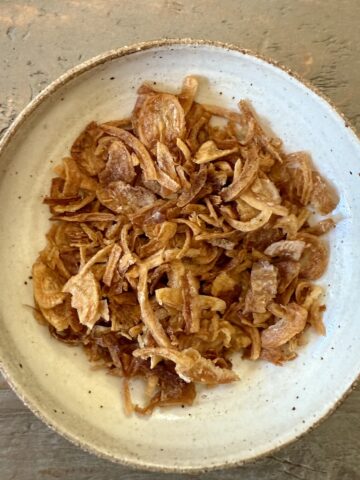

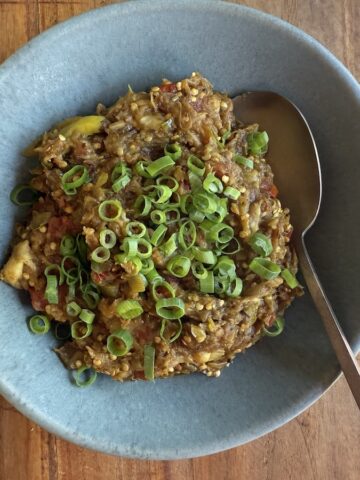

TinCook says
I love tong ho! Good to have another dish for it.
As far as hotpots, the only one we do at home is sukiyaki.
Wendy says
I always wanted to try hotpot but my husband thinks butane or propane is dangerous to handle. We use charcoal BBQ outside. (How I wish I have an outdoor natural gas BBQ!) I do not want to use my commercial electric burner because then I have to put a pot on top of it. Too cumbersome! I am afraid I may accidentally knock it off. I will start looking for a big plastic ladle to take the food out without scratching the surface of the wok and a decent electric wok from the thrift shop. Thanks for the idea.
Wendy says
Do they sell tong ho in California? I find something that looks like it but it does not have the fragrance. Is there another name in Vietnam or English or Mandarin for it?
Tincook says
I think tong ho is mandarin. aka garland chrysantheum
I see it here in SoCal at Ranch 99 sometimes.
Andrea Nguyen says
Tong Ho is mostly sold at Japanese, Chinese and Viet markets. TinCook is right -- it's widely sold. It's called tan o in Vietnamese. Here are some other names for it:
Edible Chrysanthemum, Garland Chrysanthemum, Crown daisy, Shingiku, Tong Hao, Tung Ho, Tang Ho, Chong Ho, Kor Tongho, Tong Ho Choy, Tong Hao Cai, Thung Ho, Shunigku, Kikuna, Tan O, Cai Cui, Ssukgat, Chrysanthemum Greens, Cooking Chrysanthemum, Chop Suey Greens, Khee kwai, Gul-chini.
I like the tender smaller leaf variety.
stella@raplica handbags says
i am a hot pot lover and i used it since a year,its bit risky because of the gases pressure but quite work so good and i like to take it when i go outside...thanks for ideas
Ami says
can you season the broth with dried chrysanthemum flowers that is sold for making tea?
nike air max says
Dresses, the designing and styling of which is done by quality fashion designers are called designer dresses. Till some time back designer dresses were known to be only those which had the logo of a recognizable designer but now a dress is also considered designer in terms of its styling, trimming, designing, sizes and other detailing. The way
Karen Millen Monochrome dress Black and White one dresses up, plays an important role in their personality because the sense of clothing suggests the personality of a person. All women desire to be dressed elegantly and in the best of attires. Designer dresses are a hit with women because these exhibit the latest fashion, colors, trends and sense of styling. These dresses give
Herve Leger one the freedom to invent their own look, style, comfort and fashion sense. Designer dresses are available in a variety of types, styles, fabrics and combinations. Different designer dresses are meant for different occasions. There are designer dresses
Karen Millen Graphic stripe shirt dress for occasions like cocktails, dinners, business meetings and weddings. Designer dresses are characterized by features such as elegancy, Karen Millen exotic flair, rich colors, cutting edge fashion styles, spunky and glamorous look, and distinct styling. These dresses make one look fashionable and stunning and are available in all colors, shapes, sizes, varieties and designs. In order to suit all pockets, these are available in affordable ranges as well. For women who are keen to follow latest trends for their clothing sense, designer dresses are the best option. Designer wedding dresses are a dream of every bride and
Herve Leger Strapless Bandage Dress there are beautiful patterns and designs one can choose from. According to your personality and suitability of the occasion, you can team up a designer
Herve Leger Dresses dress with appropriate accessories and end up looking fashionable, stunning and elegant. Designer dresses are the most sought after dresses and are a specific dress style that comes with some benefits. Firstly they are beneficial because of the quality of the dresses. A good quality dress is like a
Karen Millen Signature stretch satin dress cream long term investment. The quality of the dress and its fabric are an important factor in determining the wear and tear of the dress. A designer dress because of its excellent quality can be used for a longer time and occasions and still make you
Karen Millen Floral shift dress Ivory look gorgeous each time you wear it. Secondly, the designer dresses are beneficial because of the great fit they provide. In these dresses, a lot of emphasis is given to the cut and fit of the dress. Lastly, these dresses come with a good reselling value especially when it has a high designer label.With the growing use of web as medium to market and sell products, one would not need to hunt for the designer dresses all around the
Herve Leger Square-Neck Bandage Dress market place. One can simply visit their websites and shop online a stunning dress from any corner of the world
Herve Leger V-Neck Bandage Dress Black.